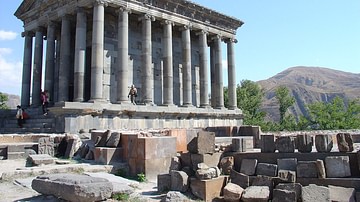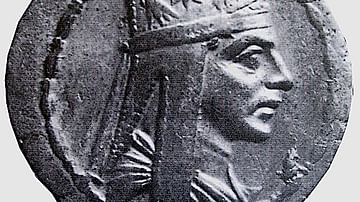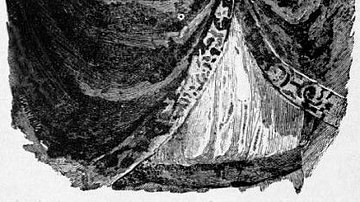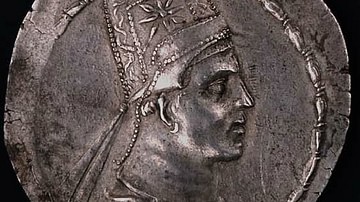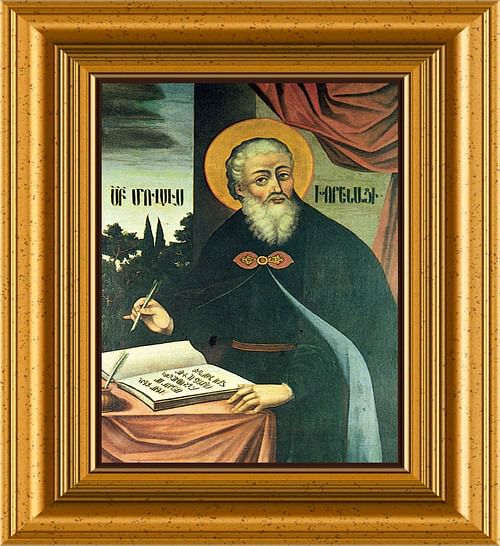
Movses Khorenatsi (Moses of Khoren) was a 5th-century CE Armenian historian whose work the History of the Armenians has earned him the title of the “father of Armenian history”. Drawing on ancient sources and ambitiously covering the history of his country up to his own lifetime, Movses' work has been instrumental in helping to create a sense of continuous history and nationhood for the Armenian people.
Biographical Details
Movses lived sometime in the 5th century CE, with the date of his birth and death usually put at c. 410 and c. 490 CE respectively, which is the period Movses himself states he lived in. However, as with many other figures in ancient Armenia, such dates are disputed due to conflicting and incomplete sources. The work of Movses does reference sources which were not available in Armenian in the 5th century CE and personalities and places which are only certainly attested to after the 5th century CE. Indeed, there are some historians, notably Robert Thomson, who consider Movses to have lived as late as the 8th century CE, a claim rejected by most Armenian historians.
Movses writes in his book that he was tutored by Mesrop Mashtots, the man credited with inventing the Armenian alphabet in 405 CE. He also says that he was sent to study at Edessa, Alexandria, Constantinople, and Athens, and that he completed his work when in old age.
History of the Armenians
As Armenian written history began with Movses, he is known as the "the father of Armenian historiography" (patmahair), although there were other 5th-century CE historians such as Eghishe, Agathangelos, and Pavstos Buzand. Movses' great work is the History of the Armenians (Patumtiun Hayots), which has become one of the most important sources of information on ancient Armenia and its neighbours from the earliest traditions in mythology to the 5th century CE. It was the first book to comprehensively and systematically cover the history of the country. Movses' work pulled together ancient texts in Greek, Assyrian, and Hebrew, oral traditions, and folk tales, and wove them into the classical and biblical tradition to create a unique continuous history of the Armenian people. To this already heady mix was added the author's own embellishments, much to the chagrin of modern historians trying to disentangle truth from fiction, iron out inconsistencies, and reconcile the book's contents with contemporary and later sources. Nevertheless, Movses deserves credit as the first Armenian writer who set out to write a comprehensive history of his country, as here explained by the modern historian R. G. Hovannisian:
For him the writing of history is not the exposition of divine providence or the preaching of right conduct. Rather, its basic purpose is to bequeath to posterity a reliable record of the deeds of great men - not only heroic and martial exploits, but also noble acts of good governance and accomplishments of learning and piety. There is no place for obscure men and unseemly deeds. (216)
Mythology: Hayk
One of the unique contributions Movses made to Armenian history was his recounting of the foundation myth of the nation (some scholars might say 'inventing'). This is the story of Hayk (Haik) and Bel and places the origins of the Armenian people as the descendants of the biblical Noah via his son Japheth. Hayk, a descendant of Japheth, rebelled one day against Bel the evil Babylonian tyrant and returned back to his homeland around Mount Ararat in ancient Armenia, where it was thought Noah's ark had come to rest at the end of the great flood. Bel followed Hayk and his relations so that a mighty battle followed in which Bel was killed. Hayk then gave his name to his descendants, the Hay people, and the name of the region of Armenia in the Armenian language, Hayasa.
A Comprehensive History
After establishing the origins of the nation to his satisfaction, Movses then proceeds to describe the evolution of the state's political institutions, the Bronze and Iron Age cultures of the region, and the history of the powerful dynastic families of Armenia. These influential clans, or nakharars, dominated the political, civilian, and military sphere of Armenia with their wealth and power based on the feudal fiefdoms they each governed. The families (with their most prominent period in brackets) include:
- The Orontids (c. 570 - c. 200 BCE)
- The Artaxiads (c. 200 BCE - c. 14 CE)
- The Arsacids (12-428 CE)
- The Mamikonians (428-652 CE)
- The Bagratuni (post 701 CE but also prominent earlier)
Of these dynasties, Movses gives special treatment to the Bagratuni (the patrons of his work) and minimises that of the Mamikonians. The great kings are given special focus, for example, such figures as Artaxias I (r. c. 200 - c. 160 BCE) and Tigranes the Great (r. c. 95 - c. 56 BCE), as well as influential clergy like Saint Gregory the Illuminator (c. 239 - c. 330 CE).

Movses' work may have chronological inconsistencies and some rulers are confused with others but there are many passages of genuine historical value. Just one example of how Movses' descriptions of events are sometimes supported by archaeological evidence is the following description of the construction of Garni in the second half of the 1st century CE by Tiridates I (Trdat I):
Trdat completed the construction of the fortress of Garni in hard and dressed blocks of stone cemented with iron [clamps] and lead. Inside, for his sister Khosrovidukht, he built a shaded residence with towers and wonderful carvings in high relief. And he composed in her memory an inscription in the Greek script. (quoted in Hovannisian, 68)
In 1945 CE, excavations at Garni revealed a partial stone inscription in Greek which names a ruler Trdat who is described as the “supreme ruler of Greater Armenia”.
Legacy
The History of the Armenians, first mass-printed in 1695 CE, influenced many later historians and intellectuals, and its comprehensive coverage of Armenia helped to foster an already growing sense of national identity and, indeed, pride from the time it was written right down to the modern day. The historical accuracy of parts of the History of the Armenians may be debatable but it, nevertheless, created a 'received' tradition, which was perhaps the author's primary intention. The book may be an exercise in myth building but it has itself become an integral part of Armenian history and tradition with such passages as the Hayk myth still being taught in Armenian schools worldwide. Indeed, Movses' work still continues to play an important role in discussions on Armenian national identity in the 21st century CE.
This article was made possible with generous support from the National Association for Armenian Studies and Research and the Knights of Vartan Fund for Armenian Studies.

